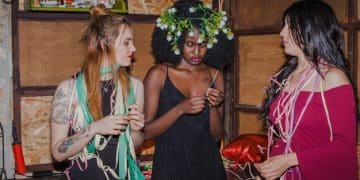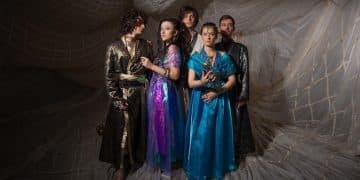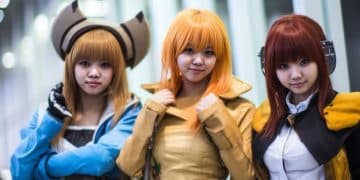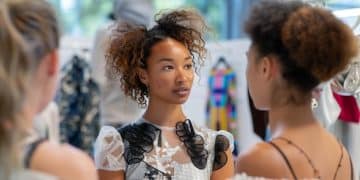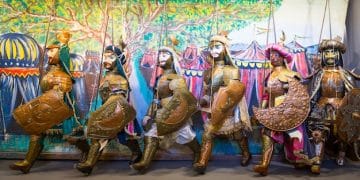Cosplay: Expressing Creativity and Fandom

Cosplay, short for “costume play,” is the art of embodying fictional characters through elaborate costumes and performances, celebrated within geek culture for its creativity, community, and dedication to fandom.
Dive into the captivating world of cosplay, where imagination comes to life through meticulously crafted costumes and passionate performances. Whether you’re a seasoned pro or a curious beginner, this guide explores everything you need to know about this vibrant art form.
What is Cosplay?
Cosplay, a fusion of “costume” and “play,” is much more than simply dressing up. It’s a performance art where individuals, known as cosplayers, create and wear costumes to embody specific characters from various sources. This involves meticulous attention to detail, from crafting the costume to adopting the character’s mannerisms.
Cosplay extends beyond mere imitation; it allows cosplayers to express their love for a particular character or series, offering a creative outlet for self-expression and community engagement. It’s a popular activity at conventions and online, fostering a sense of belonging among fans.
The Origins of Cosplay
While costume parties have existed for centuries, the modern concept of cosplay is often traced back to 1939. Forrest J Ackerman and Myrtle R. Douglas attended the 1st World Science Fiction Convention in New York dressed in futuristic costumes. However, it was in Japan during the 1970s and 1980s that cosplay truly took off, fueled by the growing popularity of anime and manga.
Japanese fans started dressing up as their favorite characters at conventions, sharing their creations and building a community around this new form of expression. As anime and manga gained international recognition, cosplay followed suit, spreading globally thanks to the internet and increasing accessibility to crafting materials.
The Appeal of Cosplay
Cosplay appeals to a wide range of people for various reasons. For some, it’s about the creative challenge of bringing a fictional character to life. For others, it’s a way to express their fandom and connect with like-minded individuals. The thrill of performing, showcasing one’s craftsmanship, and the sense of community are all significant draws.
- Creative Expression: Cosplay allows individuals to express their creativity through costume design, prop making, and performance.
- Community Building: Cosplay fosters a sense of community among fans, providing opportunities to connect with others who share similar interests.
- Personal Growth: Tackling complex projects, learning new skills, and overcoming challenges in creating costumes can lead to personal growth and increased confidence.
In conclusion, cosplay is a multifaceted hobby that blends creativity, community, and fandom. It allows participants to express themselves, connect with others, and bring their favorite characters to life in a tangible way.
Getting Started with Cosplay
Embarking on your cosplay journey can feel daunting, but it’s entirely achievable with the right approach. Start by choosing a character you genuinely admire and feel connected to. Consider your skill level and the complexity of the costume when making your selection.
Research is crucial. Gather reference images, analyze the character’s design, and plan your construction process. Don’t be afraid to start small and gradually build your skills. The most important thing is to enjoy the process of creating and embodying your chosen character.
Choosing Your Character
Selecting the right character is the first and often most important step. Consider your personal preferences, skill level, and body type. Choose a character you genuinely love and whose personality resonates with you. This will make the entire process more enjoyable and rewarding.
Think about the complexity of the costume. A character with simple clothing and minimal props may be a better starting point for beginners, while more experienced cosplayers can tackle intricate designs with armor, weapons, and detailed accessories.
Planning Your Costume
Once you’ve chosen your character, thorough planning is essential. Gather as many reference images as possible, including official artwork, screenshots from the source material, and even photos of other cosplayers who have tackled the same character. Analyze the costume’s design, materials, and construction techniques.
Create a detailed plan outlining all the components of your costume, including the materials you’ll need, the tools you’ll use, and the steps you’ll take to complete each piece. Break down the project into smaller, manageable tasks to avoid feeling overwhelmed.
Essential Materials and Tools
The materials and tools you’ll need will vary depending on the complexity of your costume, but some essentials include fabric, foam, Worbla, sewing machines, cutting tools, adhesives, paints, and various hand tools. Research the best materials for each component of your costume and invest in high-quality tools that will last.
- Fabric: Choose fabrics that match the character’s design and are appropriate for the climate and convention setting.
- Foam: EVA foam is a versatile material for creating armor, props, and other structural elements.
- Worbla: A thermoplastic material that can be molded and shaped when heated, ideal for creating intricate details and durable props.
In summary, getting started with cosplay requires careful planning, research, and a willingness to learn. Choose a character you love, break down the costume into manageable tasks, and invest in the right materials and tools. With dedication and creativity, you can bring your favorite characters to life.
Essential Skills for Cosplayers
Cosplay involves a diverse range of skills, from sewing and crafting to makeup and performance. While you don’t need to be an expert in everything, developing a solid foundation in these areas will significantly enhance your cosplay journey. Many skills can be learned through online tutorials, workshops, or by connecting with other cosplayers.
Learning new skills not only improves the quality of your costumes but also empowers you to tackle more challenging projects and express your creativity in new ways. Don’t be afraid to experiment, make mistakes, and learn from your experiences.
Sewing and Pattern Making
Sewing is a fundamental skill for creating fabric-based costumes. Learning to sew allows you to construct garments from scratch, alter existing clothing, and add intricate details to your designs. Pattern making is another valuable skill that enables you to create custom patterns tailored to your specific measurements and designs.
Start with simple sewing projects to practice basic techniques like threading a needle, stitching seams, and operating a sewing machine. Gradually progress to more complex projects like creating patterns, fitting garments, and adding embellishments.
Crafting and Prop Making
Crafting skills are essential for creating armor, weapons, and other props. This involves working with materials like foam, Worbla, resin, and various adhesives. Learning to cut, shape, and assemble these materials allows you to create realistic and durable props that complete your costume.
Experiment with different crafting techniques like foam carving, Worbla molding, and resin casting. Invest in tools like heat guns, cutting mats, and sanding blocks to make the process easier and more efficient.
Makeup and Wig Styling
Makeup and wig styling are crucial for transforming yourself into your chosen character. Learning to apply makeup correctly can enhance your features, create special effects, and bring your character’s face to life. Wig styling involves cutting, shaping, and styling wigs to match the character’s hairstyle.

Practice makeup techniques like contouring, highlighting, and eye makeup to enhance your features and create realistic effects. Learn to style wigs using techniques like cutting, teasing, and hairspray to achieve the desired look.
Performance and Posing
Performance and posing are often overlooked but are essential for truly embodying your character. This involves studying the character’s mannerisms, voice, and personality and incorporating those elements into your cosplay. Posing for photos is another important aspect, as it allows you to showcase your costume and character in the best possible light.
- Character Study: Watch the series, read the manga, or play the video game to understand your character’s personality, motivations, and mannerisms.
- Voice Acting: Practice imitating your character’s voice and catchphrases to enhance your performance.
- Dynamic Posing: Experiment with different poses that capture your character’s personality and highlight the details of your costume.
In conclusion, mastering essential skills like sewing, crafting, makeup, and performance is crucial for becoming a successful cosplayer. These skills allow you to create high-quality costumes, transform yourself into your chosen character, and connect with others through your performance.
Cosplay Communities and Conventions
Cosplay is not just a solitary hobby; it’s a thriving community that spans the globe. Cosplayers connect with each other through online forums, social media groups, and in-person events like conventions. These platforms provide opportunities to share knowledge, collaborate on projects, and showcase their creations to a wider audience.
Attending conventions is a highlight for many cosplayers, offering a chance to meet fellow enthusiasts, participate in competitions, and display their costumes in a celebratory environment. Conventions foster a sense of belonging and provide a platform for cosplayers to express their passion.
Online Communities
Online communities are a vital resource for cosplayers, offering a space to share tips, ask questions, and connect with others who share similar interests. Websites like Cosplay.com, Reddit’s r/cosplay, and various Facebook groups provide platforms for cosplayers to interact, exchange ideas, and support each other.
These communities are invaluable for beginners seeking advice on costume construction, makeup techniques, or wig styling. Experienced cosplayers often share their knowledge and provide feedback, creating a supportive environment for learning and growth.
Cosplay Conventions
Cosplay conventions are events dedicated to cosplay and fan culture. These conventions bring together cosplayers, artists, vendors, and fans from around the world, offering a vibrant and exciting atmosphere. Conventions feature costume contests, panels, workshops, and opportunities to meet special guests.
Attending a cosplay convention is an immersive experience that allows you to connect with fellow enthusiasts, showcase your costumes, and celebrate your love for fandom. Conventions range in size from small local events to large international gatherings like Comic-Con International in San Diego and Anime Expo in Los Angeles.
Etiquette and Best Practices
When participating in cosplay communities and attending conventions, it’s important to adhere to certain etiquette guidelines. Respecting other cosplayers, being mindful of personal space, and following convention rules are essential for creating a positive and inclusive environment.
- Consent: Always ask for permission before taking photos of cosplayers.
- Respect: Respect cosplayers’ costumes and personal boundaries.
- Positivity: Promote a positive and supportive atmosphere.
In summary, cosplay communities and conventions are integral to the cosplay experience. They provide opportunities to connect with fellow enthusiasts, share knowledge, and celebrate your love for fandom. By participating in these communities and adhering to etiquette guidelines, you can contribute to a positive and inclusive environment for all.
Advanced Cosplay Techniques
As you gain experience in cosplay, you may want to explore more advanced techniques to elevate the quality and realism of your costumes. This can involve mastering complex crafting methods, incorporating electronics and lighting, and creating elaborate special effects.
Experimenting with advanced techniques requires dedication, patience, and a willingness to learn. Many resources are available online, including tutorials, forums, and workshops, offering guidance and inspiration for aspiring cosplayers.
Armor Construction
Creating realistic and durable armor is a challenging but rewarding aspect of cosplay. This involves working with materials like EVA foam, Worbla, and fiberglass, using techniques like pattern making, heat shaping, and layering to create intricate designs.
Armor construction requires precision, patience, and attention to detail. Understanding the properties of different materials and mastering techniques like seam welding, edge trimming, and surface finishing are essential for creating high-quality armor.
Electronics and Lighting
Incorporating electronics and lighting into your costumes can add a new dimension of realism and visual appeal. This can involve adding LED lights, sound effects, or even motorized components to your props and costumes.

Working with electronics requires basic knowledge of circuits, soldering, and wiring. Experiment with different types of lights, sensors, and microcontrollers to create unique and innovative effects.
Weathering and Distressing
Weathering and distressing techniques are used to create a sense of age, wear, and realism in your costumes. This can involve techniques like dry brushing, layering, and using weathering powders to simulate dirt, rust, and battle damage.
Weathering and distressing require a keen eye for detail and an understanding of how different materials age over time. Experiment with different techniques to create realistic and convincing effects.
- Dry Brushing: Use a dry brush and a small amount of paint to create subtle highlights and shadows.
- Layering: Apply multiple layers of paint or weathering powders to build up depth and texture.
- Weathering Powders: Use weathering powders to simulate dirt, rust, and other types of wear.
In conclusion, mastering advanced cosplay techniques like armor construction, electronics and lighting, and weathering and distressing can elevate the quality and realism of your costumes. These techniques require dedication, patience, and a willingness to learn, but the results can be truly spectacular.
The Future of Cosplay
Cosplay continues to evolve as technology advances and new trends emerge. The increasing accessibility of 3D printing, laser cutting, and other digital fabrication tools is opening up new possibilities for costume construction. Virtual reality and augmented reality are also poised to play a significant role in the future of cosplay, allowing cosplayers to create immersive and interactive experiences.
The future of cosplay is bright, with endless opportunities for innovation, creativity, and community engagement. As technology continues to evolve, cosplayers will continue to push the boundaries of what’s possible, creating ever more elaborate and breathtaking costumes and performances.
3D Printing and Digital Fabrication
3D printing is revolutionizing costume construction, allowing cosplayers to create intricate and highly detailed props, armor pieces, and accessories. 3D printers are becoming more affordable and accessible, making it easier for cosplayers to bring their designs to life.
Digital fabrication tools like laser cutters and CNC machines are also transforming the cosplay landscape. These tools allow cosplayers to cut precise shapes from materials like foam, acrylic, and wood, creating accurate and professional-looking costume components.
Virtual Reality and Augmented Reality
Virtual reality (VR) and augmented reality (AR) are poised to revolutionize the cosplay experience, allowing cosplayers to create immersive and interactive performances. VR can transport cosplayers to virtual environments, while AR can overlay digital effects onto their costumes and surroundings.
Imagine a cosplayer dressed as Iron Man using AR to project a holographic heads-up display onto their helmet or a cosplayer dressed as a wizard casting virtual spells with hand gestures. These technologies have the potential to transform cosplay from a static display into a dynamic and interactive performance art.
Sustainability and Ethical Practices
As cosplay becomes more popular, it’s important to consider the environmental and ethical implications of costume construction. Using sustainable materials like recycled fabrics and eco-friendly adhesives can help reduce the environmental impact of cosplay.
Supporting ethical labor practices and avoiding the use of materials sourced from exploited or endangered species is also crucial. By making conscious choices about the materials you use and the companies you support, you can help create a more sustainable and ethical cosplay community.
In conclusion, the future of cosplay is bright, with exciting opportunities for innovation, creativity, and community engagement. As technology continues to evolve and new trends emerge, cosplayers will continue to push the boundaries of what’s possible, creating ever more elaborate and breathtaking costumes and performances. By embracing sustainability and ethical practices, the cosplay community can ensure a positive and responsible future for this vibrant art form.
| Key Takeaway | Brief Description |
|---|---|
| 🎨 Creativity and Expression | Cosplay offers a unique outlet for expressing creativity through costume design and performance. |
| 🤝 Community Connection | It fosters community among fandom enthusiasts, offering opportunities for connection. |
| 🛠️ Skill Development | Participants develop various skills, including sewing, crafting, makeup, and performance. |
| 🎉 Convention Experience | Conventions serve as a hub for cosplayers to showcase their creations and engage in competitions. |
Frequently Asked Questions (FAQ)
▼
Cosplay is short for “costume play” and refers to the practice of dressing up as characters from various media, particularly anime, manga, video games, and comic books. It involves creating and wearing costumes to embody these characters.
▼
Choose a character you love and whose personality resonates with you. Consider your skill level and the complexity of the costume. Start with simpler projects and gradually tackle more challenging ones as your skills improve.
▼
Cosplay materials can be purchased from various sources, including fabric stores, craft stores, online retailers, and specialized cosplay supply shops. Research the best materials for your project and compare prices to find the best deals.
▼
Join online cosplay communities on websites like Cosplay.com, Reddit, and Facebook groups. Attend cosplay conventions and events to meet fellow enthusiasts in person. Share your creations online and interact with other cosplayers.
▼
Study your character’s mannerisms, voice, and personality. Practice your poses and expressions. Stay in character and interact with other cosplayers and attendees. Most importantly, have fun and express your love for your chosen character.
Conclusion
Cosplay offers a captivating blend of creativity, community, and fandom, providing enthusiasts with a unique platform for self-expression and skill development. From meticulous costume design to passionate performances, cosplay celebrates the art of embodying beloved characters and fostering connections within a global community of fans. As technology continues to shape its future, cosplay promises endless opportunities for innovation and engagement.
